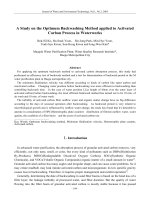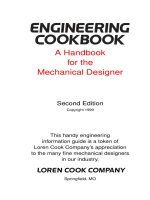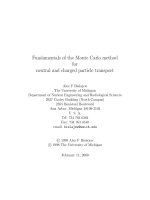A primer for the monte carlo method 1994 sobol
Bạn đang xem bản rút gọn của tài liệu. Xem và tải ngay bản đầy đủ của tài liệu tại đây (3.1 MB, 124 trang )
for 'h
r!&Monro
Carlo
-
Ct
Primer
for the
Monte
Carlo
Method
llya M. Sobol'
CRC Press
Boca Raton Ann Arbor London Tokyo
Library of Congress Cataloging-in-Publication Data
Sobol', I. M. (Il'ia Meerovich)
[Metod Monte-Karlo. English]
A primer for the Monte Carlo method / Ilya M. Sobol'.
P.
cm.
Includes bibliographical references and index.
ISBN 0-8493-8673-X
1. Monte Carlo method. I. Title.
QA298S6613
51 9 . 2 ' 8 2 4 ~ 2 0
93-50716
CIP
This book cor
authentic and
xl with perrnishighly regarded sc
sion, and source:
references are
;h reliable data
listed. Reasonable
and information,
cannot assume
responsibility for 1
e consequences
of their use.
I or transmitted
Neither this bo
zical, including
in any form or bj
ny information
photocopying, mil
storage or retrieval system, without prior permission in writing from
the publisher.
CRC Press, Inc.'s consent does not extend to copying for general
distribution, for promotion, for creating new works, or for resale.
Specific permission must be obtained in writing from CRC Press for
such copying.
Direct all inquiries to CRC Press, Inc., 2000 Corporate Blvd.,
N.W., Boca Raton, Florida 33431.
O 1994 by CRC Press, Inc.
No claim to original U.S. Government works
International Standard Book Number 0-8493-8673-X
Library of Congress Card Number 93-50716
Printed in the United States of America 1 2 3 4 5 6 7 8 9 0
Printed on acid-free paper
publishing history
This book was published in Russian in 1968, 1972,
and 1978. While it is a popular book, it is referred
to in rigorous applied papers; teachers also use it
as a textbook. With this in mind, the author largely
revised the book and published its fourth edition in
Russian in 1985.
In English, the book was first published in 1974
by Chicago University Press without the author's permission (the USSR joined the Universal Copyright
Convention only in 1973). The second English publication was ,by Mir Publishers, in 1975 and 1985
(translations of the second and third Russian editions).
The fourth edition of the book was translated only
into German ( 1991, Deutscher Verlag de Wissenschaften).
The Monte Carlo method is a numerical method
of solving mathematical problems by random sarnpling. As a universal numerical technique, the Monte
Carlo method could only have emerged with the appearance of computers. The field of application of the
method is expanding with each new computer generation.
This book contains the main schemes of the Monte
Carlo method and various examples of how the method can be used in queuing theory, quality and reliability estimations, neutron transport, astrophysics,
and numerical analysis.
The principal goal of the book is to show researchers, engineers, and designers in various areas (science, technology, industry, medicine, economics, agriculture, trade, etc.) that they may encounter problems in their respective fields that can be solved by
the Monte Carlo method.
The reader is assumed to have only a basic knowledge of elementaxy calculus. Section 2 presents the
concept of random variables in a simple way, which
is quite enough for understanding the simplest procedures and applications of the Monte Carlo method.
The fourth revised and enlarged Russian edition
(1985; German trans. 1991) can be used as a university textbook for students-nonrnathematicians.
The principal goal of this book is to suggest to
specialists in various areas that there are problems
in their fields that can be solved by the Monte Carlo
method.
Many years ago I agreed to deliver two lectures on
the Monte Carlo method, at the Department of Computer Technology of the Public University in Moscow.
Shortly before the first lecture, I discovered, to my
horror, that most of the audience was unfamiliar with
probability theory. It was too late to retreat: more
than two hundred listeners were eagerly waiting. Accordingly, I hurriedly inserted in the lecture a supplementary part that surveyed the basic concepts of
probability. This book's discussion of random variables in Chapter 1 is an outgrowth of that part, and
I feel that I must say a few words about it.
Everyone has heard, and most have even used.
the words "probability" and "random variable." The
intuitive idea of probability (considered as frequency)
more or less corresponds to the true meaning of the
term. But the layman's notion of a random variable
is rather different from the mathematical definition.
Therefore, the concept of probability is assumed to
be understood, and only the more complicated concept of the random variable is clarified in the first
chapter. This explanation cannot replace a course in
probability theory: the presentation here is simplified, and no proofs are given. But it does give the
reader enough acquaintance with random variables
for a n understanding of Monte Carlo techniques.
The problems considered in Chapter 2 are fairly
simple and have been selected from diverse fields.
Of course, they cannot encompass all the areas in
which the method can be applied. For example, not
a word in this book is devoted to medicine, although
the method enables u s to calculate radiation doses
in X-ray therapy (see Computation of Neutron Transmission Through a Plate in Chapter 2). If we have a
program for computing the absorption of radiation in
various body tissues, we can select the dosage and
direction of irradiation that most efficiently ensures
that no harm is done to healthy tissues.
The Russian version of this book is popular, and is
often used as a textbook for students-nonrnathematicians. To provide greater mathematical depth, the
fourth Russian edition includes a new Chapter 3 that
is more advanced than the material presented in the
preceding editions (which assumed that the reader
had only basic knowledge of elementary calculus).
The present edition also contains additional information on different techniques for modeling random variables, a n approach to quasi-Monte Carlo methods,
and a modem program for generating pseudorandom
numbers on personal computers.
Finally, I am grateful to Dr. E. Gelbard (Argonne
National Laboratory) for encouragement in the writing.
I. Sobol'
Moscow, 1993
introduction
general idea of the method
The Monte Carlo method is a numerical method of
solving mathematical problems by the simulation of
random variables.
T h e Origin of the Monte Carlo Method
The generally accepted birth date of the Monte
Carlo method is 1949, when an article entitled 'The
Monte Carlo method" by Metropolis and Ulaml appeared. The American mathematicians John von Neumann and Stanislav Ulam are considered its main
originators. In the Soviet Union, the first papers on
the Monte Carlo method were published in 1955 and
1956 by V. V. Chavchanidze, Yu. A. Shreider and
V. S. Vladimirov.
Curiously enough, the theoretical foundation of
the method had been known long before the von
Neumann-Ulam article was published. Furthermore,
well before 1949 certain problems in statistics were
sometimes solved by means of random sampling that is, in fact, by the Monte Carlo method. However,
because simulation of random variables by hand is
a laborious process, use of the Monte Carlo method
a s a universal numerical technique became practical
only with the advent of computers.
As for the name "Monte Carlo," it is derived from
that city in the Principality of Monaco famous for its
. . . casinos. The point is that one of the simplest
mechanical devices for generating random numbers
is the roulette wheel. We will discuss it in Chapter 2 under Generating Random Variables on a Computer. But it appears worthwhile to answer here one
frequently asked question: "Does the Monte Carlo
method help one win at roulette?" The answer is No;
it is not even an attempt to do so.
Example: the "Hit-or-Miss" Method
We begin with a simple example. Suppose that
we need to compute the area of a plane figure S. This
may be a completely arbitrary figure with a curvilinear boundary; it may be defined graphically or analytically, and be either connected or consisting of several
parts. Let S be the region drawn in Figure 1, and let
us assume that it is contained completely within a
unit square.
Choose at random N points in the square and designate the number of points that happen to fall inside
S by N1. It is geometrically obvious that the area of S
is approximately equal to the ratio WIN.The greater
the N , the greater the accuracy of this estimate.
The number of points selected in Figure 1 is N =
40. Of these, N' = 12 points appeared inside S. The
ratio N 1 / N = 12/40 = 0.30, while the true area of S is
0.35.
In practice, the Monte Carlo method is not used for
calculating the area of a plane figure. There are other
methods [quadrature formulas) for this, that, though
they are more complicated, provide much greater accuracy.
Fig. 1. N random points in the square. Of
these, N' points are inside S. The area of S is
approximately N' I N .
However, the hit-or-miss method shown in our example permits us to estimate, just as simply, the
"multidimensionalvolume" of a body in a multidimensional space; in such a case the Monte Carlo method
is often the only numerical method useful in solving
the problem.
Two Distinctive Features
of the Monte Carlo Method
One advantageous feature of the Monte Carlo
method is the simple structure of the computation
algorithm. As a rule, a program is written to carry
out one random trial (in our previous "hit-or-miss"
example one has to check whether a selected ran-
Fig. 2. N random hits in the square. Of these,
N' hits inside S. Is the area approximately
N1/N?
come acquainted with the definition of random variables and with some of their properties. This information is presented in the first part of Chapter 1
under Random Variables. A reader who is familiar
with probability theory may omit this section, except
for the discussion entitled The General Scheme of the
Monte Carlo Method.
The procedures by which the random points in
Figures 1 and 2 are actually computed are revealed
at the end of Chapter 1 (see Again About the Hit-orMiss Examples).
Professor Ilya M. Sobol' was born in 1926 in Panevezys, Lithuania. He currently holds the position
of Chief Researcher at the Institute for Mathematical
Modeling, which is a division of the Russian Academy
of Sciences, in Moscow.
His scientific interests include computational
mathematics (primarily problems related to the Monte
Carlo method), uniformly distributed sequences of
points, multidimensional quadrature formulas, quasiMonte Carlo methods, and multiple criteria decisionmaking.
Professor Sobol's publications include The Method of Statistical ?fials (Monte Carlo method), Pergamon, 1964 (with N. P. Buslenko, D. I. Golenko, et
al.); Multidimensional Quadrature Formulas and Haar
Functions, Nauka, 1969 (Russian); Numerical Monte
Carlo Methods, Nauka, 1973 (Russian); Selection of
Optimal Parameters in Problems with Several Criteria,
Nauka, 1981 (with R. B. Statnikov, Russian); Comptonization and the Shaping of X-Ray Source Spectra:
Monte CarLo Calculations, Harwood Academic Publishers, 1983 (with R. A. Syunyaev and L. A. Pozdnyakov); Points Which Unrormly Fill a Multidimensional Cube, Znanie, 1985 (Russian); and The Monte
Carlo Method Nauka, 1968, 1972, 1978, 1985.
contents
1 SIMULATING RANDOM VARIABLES
1
Random Variables
1
Generating Random Variables on a Computer
Transformations of Random Variables
23
2 EXAMPLES OF THE APPLICATION
OF THE MONTE CARLO =HOD
Simulation of a Mass-Servicing System
Calculating the Quality and Reliability
of Devices
40
Computation of Neutron Transmission
Through a Plate
47
An Astrophysical Problem
56
59
Evaluating a Definite Integral
35
35
3 ADDITIONAL INFORMATION
69
On Pseudorandom Numbers
69
On Methods for Generating Random Variables
On Monte Carlo Algorithms
93
REFERENCES
INDEX
105
103
17
73
Fi
Primer
for the
Monte
Carlo
Method
simulating
random variables
random variables
We assume that the reader is acquainted with the
concept of probability, and we turn directly to the
concept of a random variable.
The words "random variable," in ordinary lay usage, connote that one does not know what value a
particular variable will assume. However, for mathematicians the term "random variable" has a precise
meaning: though we do not know this variable's value
in any given case, we do know the values it can assume and the probabilities of these values. The result
of a single trial associated with this random variable
cannot be precisely predicted from these data, but we
can predict very reliably the result of a great number
of trials. The more trials there are (the larger the
sample), the more accurate our prediction.
Thus, to define a random variable, we must indicate the values it can assume and the probabilities
of these values.
Discrete Random Variables
A random variable J is called discrete if it can assume any of a set of discrete values 1 1 ,x 2 , . . . , x n . A
discrete random variable is therefore defined by a table
; ::: ;:)
(
(TI
where x l , x 2 , . . . , x n are the possible values of J, and
pl , p 2 , . . . ,pn are the corresponding probabilities. To
be precise, the probability that the random variable J
will be equal to xi (denoted by P{J = x i ) ) is equal to
Pi :
P{J = x i ) = pi
Table (T) is called the distribution of the random variable J.
The values X I , x 2 , . . . , xn can be arbitrary.* However, the probabilities pl , p 2 , . . . , p, must satisfy two
conditions:
1.
All pi are positive:
2.
The sum of all the pi equals 1:
p1+p2+...+pn
=1
(1.2)
The latter condition requires that in each trial, J must
necessarily assume one of the listed values.
The number
n
MJ =
C xipi
(1.3)
i=l
is called the mathematical expectation, or the expected
value, of the random variable J.
*In probability theory discrete random variables that can
assume an infinite sequence of values are also considered.
2
simulating random variables
To elucidate the physical meaning of this value,
we rewrite it in the following form:
From this relation, we see that ME is the average
value of the variable (, in which more probable values are included with larger weights. ( ~ i e r a g i with
n~
weights is of course very common in science. In mechanics, for example, if masses ml, mz,. . . , m, are located at the points x l , x2,.. . , x, on the x axis, then
the center of gravity of this system is given by the
equation
Of course, in this case the sum of all the masses does
not necessarily equal one.)
Let u s mention the basic properties of the expected
value. If c is a n arbitrary nonrandom number, then
and
M(c0 = cM<
(1.5)
If J and q are two arbitrary random variables, then
The number
is called the variance of the random variable <. Thus,
the variance is the expected value of the squared deviation of the random variable from its average value
ME. Obviously, D< is always greater than zero.
<
chapter 1
3
The expected value and the variance are the most
important numerical characteristics of the random
variable J . What is their practical value?
If we observe the variable J many times and obtain the values , t2,. . . , EN (each of which is equal to
one of the numbers x l , x 2 , . . . , x , ) , then the arithmetic
mean of these values is close to M J :
and the variance DJ characterizes the spread of these
values around the mean value M J .
Equation 1.8 is a simple case of the famous law
of large numbers and can be explained by the following considerations. Assume that among the obtained
values J 1 , J 2 , . . . , J N the number x l occurs kl times,
the number x 2 occurs kg times, . . . , and the number
x , occurs kn times. Then
Hence,
At large N , the frequency k i / N of the value xi approaches its probability pi so that k i / N = p i . Therefore,
N
-1 ~ = &o+ & i P i = M J
j=1
i=l
i=l
Equation 1.7 for the variance can be transformed
using Equations 1.4, 1.5, and 1.6:
4
simulating random variables
from which it follows that
Usually the computation of variance by Equation 1.9
is simpler than by Equation 1.7.
The variance has the following basic properties. If
c is an arbitrary nonrandom number, then
and
D(c() = C'DE
(1.11)
The concept of independence of random variables plays an important role in probability theory.
Independence is a rather complicated concept, though
it may be quite clear in the simplest cases. Let us
suppose that we are simultaneously observing two
random variables ( and q. If the distribution of (
does not change when we know the value that 7) assumes, then it is natural to consider ( independent
of 7).
The following relations hold for independent random variables ( and q:
and
D((+q) = D ~ + D v
Example: Throwing a Die
Let us consider a random variable
bution specified by the table
(1.13)
x
with distri-
Clearly, H can assume the values 1, 2, 3, 4. 5, 6, and
each of these values is equally probable. So, the number of pips appearing when a die is thrown can be
used to calculate H.
chapter 1
5
According to Equation 1.3
1
1
1
Mx=1.-+2.-+...+6.-=3.5
6
6
6
and according to Equation 1.9
Example: Tossing a Coin
Let u s consider a random variable 0 with distribution
The game of tossing a coin, with the agreement that
a head counts three points and a tail counts four
points, can be used to generate 6. Here
and
1
1
DO = 3' . - + 4' . - - (3.5)' = 0.25
2
2
We see that M6 = MH, but DO < DH. This could
easily have been predicted, since the maximum deviation of 0 from 3.5 is f0.5, while for the values of H,
the spread can reach &2.5.
Continuous Random Variables
Let us assume that some radium is placed on a
Cartesian plane at the origin. As an atom of radium decays, an a-particle is emitted. Its direction
is described by the angle (Figure 1.1). Since, both
in theory and practice, any direction of emission is
possible, this random variable can assume any value
from 0 to 2 ~ .
We shall call a random variable continuous if it can
assume any value in a certain interval (a, b ) .
+
6
simulating rQndom variables
Fig. 1.1. Random direction.
Fig. 1.2. Probability density.
A continuous random variable J is defined by specifjnng an interval containing all its possible values,
and a function p(z) that is called the probability density of the random variable J [or the distribution density of t).
The physical meaning of p(z) is as follows: let
(a', b') be an arbitrary interval contained in (a, b) (that
is, a 5 a', 'b 5 b). Then the probability that J falls in
the interval (a', b') is equal to the integral
This integral (1.14) is equal to the shaded area in
Figure 1.2.
chapter 1
7
The set of values of [ can be any interval. The
cases a = -co and/or b = co are also possible. However, the density p(x) must satisfy two conditions
analogous to conditions (1.1) and (1.2) for discrete
variables:
1.
The density p(x) is positive inside (a, b):
2.
The integral of the density p(x) over the whole
interval (a, b) is equal to 1:
The number
is called the expected value of the continuous random
variable t.
The expected value has the same meaning as in
the case of a discrete random variable. Indeed, since
it can easily be seen that this is the average value of
J: any value of x from the interval (a, b) enters the
integral with its weight p(x) dx.
(In this case we also have an analogous equation
in mechanics: if the linear density of a rod a < x < b
8
simulating random variables









